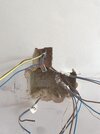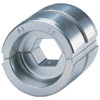I am helping my sister with an electric job that’s been left midway by the builder. I noticed today that a wire was taped as it entered the metal socket box from the wall. When I unwrapped the tape, a piece of the neutral fell into my hand. No attempt was made to join the cable. It was just taped to give the impression of a complete cable. It was the feed for a heat alarm.
The 1.5mm twin and earth was buried inside plaster as it travelled up the wall. There was no option to replace the cable or trace it up to the ceiling void where I could have put a joint inside a box.
I was unsure on how to approach this and in the end used a wago (wrapped in insulation tape) and chose to bury it in filler that wil be used to make this good.
Was this the right thing to do?
The rest of the damage is due to the metal box being 25mm and not being deep enough for the dimmer switches. I replaced it with a 47mm box.
The 1.5mm twin and earth was buried inside plaster as it travelled up the wall. There was no option to replace the cable or trace it up to the ceiling void where I could have put a joint inside a box.
I was unsure on how to approach this and in the end used a wago (wrapped in insulation tape) and chose to bury it in filler that wil be used to make this good.
Was this the right thing to do?
The rest of the damage is due to the metal box being 25mm and not being deep enough for the dimmer switches. I replaced it with a 47mm box.




